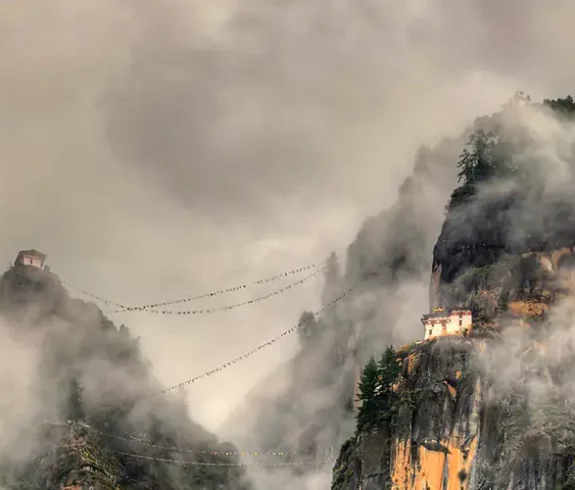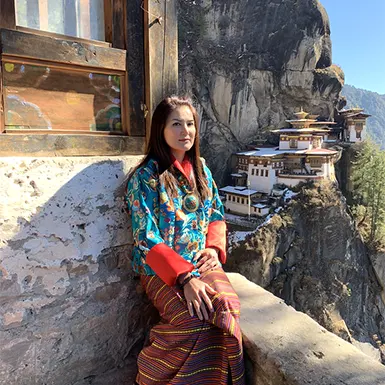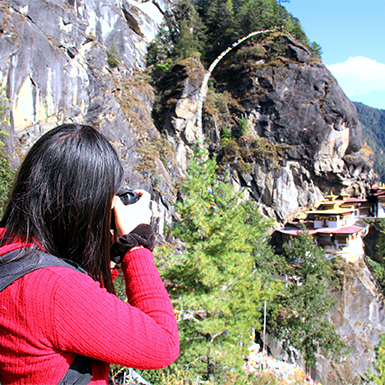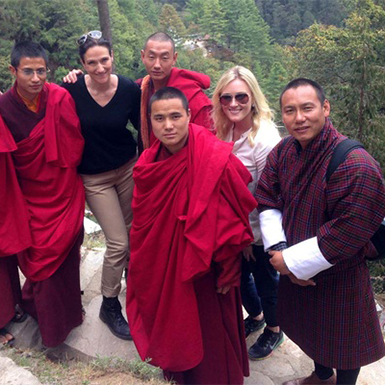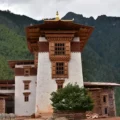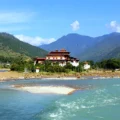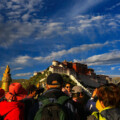Bhutan, nestled in the Eastern Himalayas, provides a unique travel experience with its stunning landscapes and rich cultural heritage. This kingdom stands out as a destination where tradition harmoniously coexists with modernity. Tourists in Bhutan can explore a nation that prioritizes sustainable tourism and cultural preservation, ensuring future generations enjoy its natural beauty and ancient traditions.
Bhutan’s Sustainable Tourism Approach
- High Value, Low Impact Tourism: Bhutan enforces a “High Value, Low Impact” tourism policy to prevent overtourism. This strategy ensures that the number of visitors is manageable for the country’s infrastructure and cultural sites, preserving an authentic and serene environment for locals and tourists.
- Sustainable Development Fee: As part of their travel expenses, tourists in Bhutan pay a Sustainable Development Fee. This fee funds vital services such as healthcare and education and supports environmental conservation and cultural preservation efforts. This policy ensures that tourism contributes to the local community and aligns with the country’s sustainable development goals.
- Cultural Preservation: The revenue from the Sustainable Development Fee also supports the preservation of Bhutan’s cultural heritage. This effort includes maintaining ancient fortresses known as dzongs, supporting traditional festivals called tsechus, and promoting local arts and crafts. This emphasis on cultural preservation allows tourists in Bhutan to engage with the country’s traditions authentically and meaningfully.
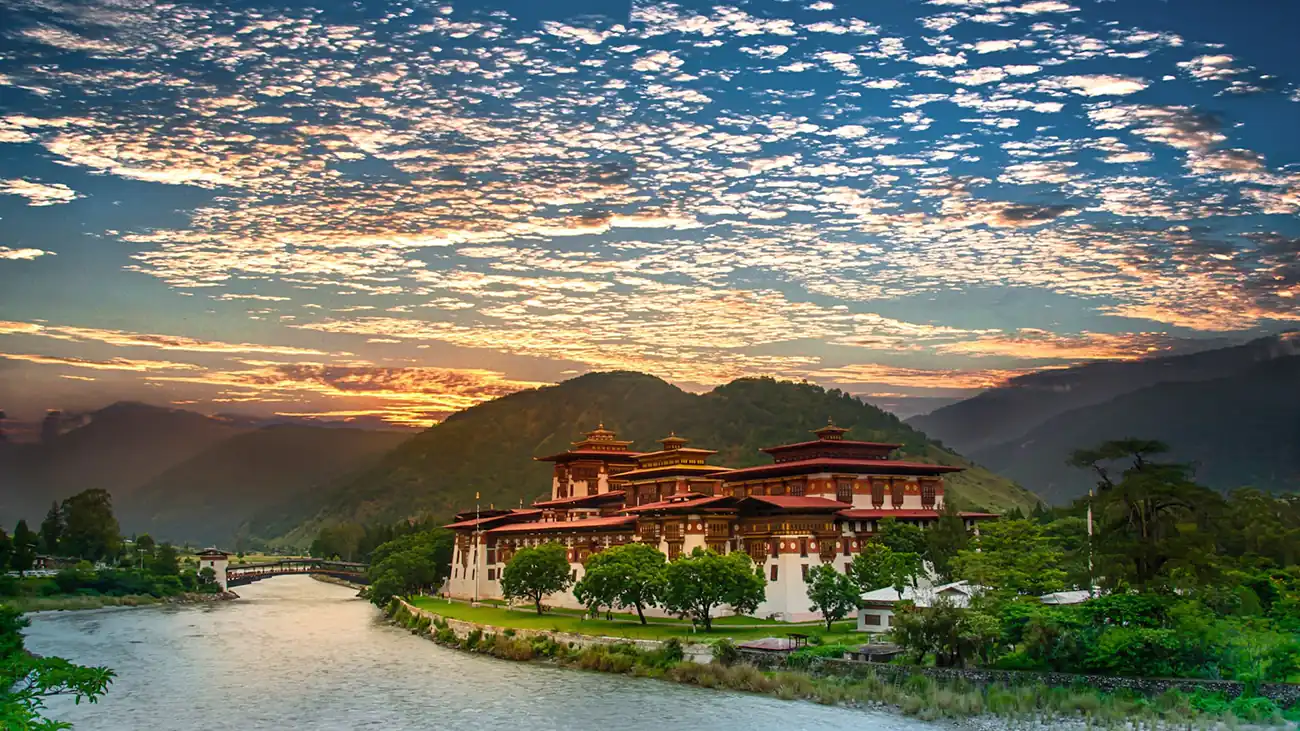
Getting There and Visa Requirements for Tourists in Bhutan
Planning your trip to Bhutan involves understanding the entry points and visa process. Here’s what you need to know:
Reaching Bhutan
Tourists in Bhutan typically arrive by air or land:
- By Air: Paro International Airport (PBH) is Bhutan’s sole international airport. Direct flights are available from select Asian cities, including Bangkok, Delhi, Kolkata, Kathmandu, and Singapore. Drukair, the national airline, and Bhutan Airlines, are the primary carriers.
- By Land: Indian tourists can enter Bhutan through the land borders at Phuentsholing, Gelephu, and Samdrup Jongkhar. They must obtain a permit.
Visa Requirements
All tourists, except citizens of India, Bangladesh, and the Maldives, need a visa to enter Bhutan. The visa process is unique:
Licensed Tour Operator: You must book your trip through a Bhutanese tour operator. They will handle your visa application.
Minimum Daily Tariff: Tourists in Bhutan pay a minimum daily tariff, currently set at USD 350 per person per day during the high season (March-May, September-November) and USD 300 per person per day during the low season (December-February, June-August). This tariff covers the following:
- Accommodation in standard hotels.
- All meals.
- Transportation within Bhutan.
- A licensed tour guide.
- Tourists in Bhutan must pay a Sustainable Development Fee of USD 100 per day.
Visa Approval: Once you’ve paid the tariff and submitted your visa application, your tour operator will process it and secure your visa clearance letter. You’ll need this letter to board your flight or enter at a land border.
Visa on Arrival: Immigration officials will stamp your visa in your passport upon arrival in Bhutan.
Best Times to Visit Bhutan: A Year-Round Destination
Tourists in Bhutan can explore this captivating kingdom year-round, but the Best Time for Bhutan Tour depends on your preferences and desired activities:
- Spring (March-May): Mild temperatures and blooming wildflowers make spring an enchanting time for tourists in Bhutan. It’s perfect for trekking and enjoying outdoor activities.
- Summer (June-August): Though the monsoon season brings rain, it also transforms Bhutan into a lush, green paradise. Summer offers a quieter experience with fewer tourists and lower prices.
- Autumn (September-November): With clear skies, vibrant festivals, and stunning Himalayan views, autumn is a popular choice for tourists in Bhutan.
- Winter (December-February): Tourists seeking a snowy wonderland will love Bhutan in winter. The landscapes are breathtaking, and it’s a beautiful time for cultural exploration.
Must-Visit Attractions Across the Kingdom
Bhutan, a land of captivating beauty and rich traditions, beckons tourists with a wealth of attractions that showcase its natural splendor, cultural treasures, and spiritual heart.
Iconic Landmarks and Cultural Gems
- Tiger’s Nest Monastery (Paro Taktsang): A challenging hike rewards tourists in Bhutan with breathtaking views and a sense of spiritual awe at this iconic Taktsang monastery, perched dramatically on a cliffside.
- Punakha Dzong: This majestic fortress, a masterpiece of Bhutanese architecture, stands at the meeting point of two rivers. It was once the capital of Bhutan and remains a place of immense cultural and religious significance.
- Folk Heritage Museum (Thimphu): Tourists in Bhutan can step back in time at this living museum, where they can witness traditional rural life through authentic artifacts, tools, and a replica of a traditional Bhutanese home.
- National Memorial Chorten (Thimphu): This grand white stupa, adorned with golden spires, invites locals and tourists to gather, pray, meditate, and find solace.
- Tashichho Dzong (Thimphu): This imposing fortress serves as the seat of Bhutan’s government and the summer residence of Je Khenpo, the chief abbot, highlighting its cultural and political importance.
Natural Wonders for Tourists in Bhutan
Beyond its cultural riches, Bhutan’s pristine natural beauty captivates tourists:
- Phobjikha Valley: Tourists in Bhutan who are avid birdwatchers flock to this glacial valley, a winter sanctuary for endangered black-necked cranes.
- Jigme Dorji National Park: Bhutan’s expansive national park is home to many plants and animals. Trekkers and nature enthusiasts can spot snow leopards, takins (the national animal), and blue sheep amidst stunning landscapes.
- Royal Manas National Park: Bordering India, this park protects a vast swathe of subtropical forest, providing a haven for tigers, elephants, and countless bird species.
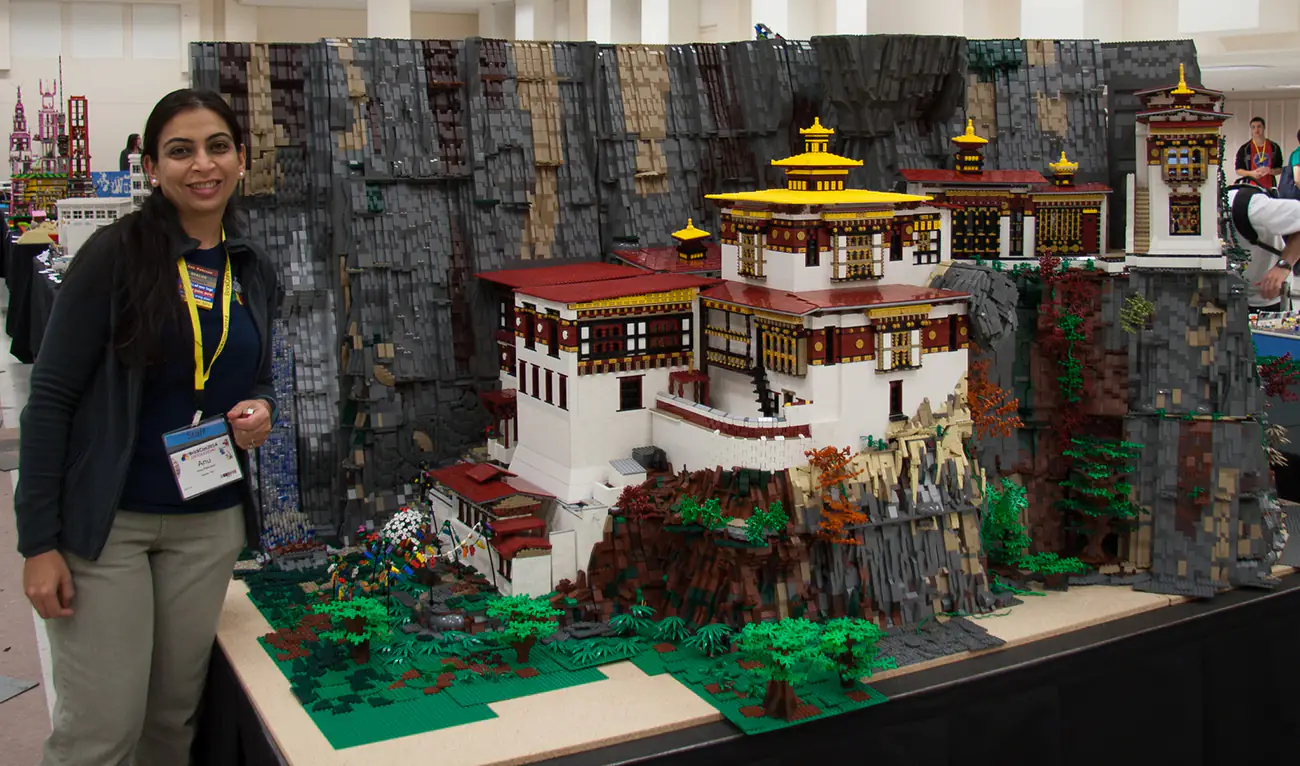
Embracing Bhutan’s Rich Culture: A Guide for Tourists
Bhutan offers tourists a vibrant cultural tapestry to explore, inviting you to discover the heart and soul of this Himalayan nation. Embrace the traditions, etiquette, and customs that make Bhutan so unique.
Festive Celebrations: A Tapestry of Tradition
Tourists in Bhutan frequently visit to coincide with the vibrant “tsechus” festivals. These events burst with color, showcasing masked dances, traditional music, and sacred rituals. Don’t miss these popular festivals:
- Paro Tshechu: At Paro Rinpung Dzong, witness elaborate dances and the unveiling of a giant thangka (religious scroll).
- Thimphu Tshechu: In the capital city, masked dancers reenact historical and religious stories.
- Punakha Drubchen and Tshechu: This festival commemorates a 17th-century battle with a dramatic reenactment using traditional weaponry.
Music and Dance: The Heartbeat of Bhutanese Life
Bhutanese culture deeply integrates music and dance. Tourists can experience these art forms through:
- Traditional Dance Performances: Many hotels and cultural centers host performances that showcase Bhutanese dances and often narrate tales of deities, heroes, and everyday life.
- Folk Music: Enchant your ears with the melodies of traditional Bhutanese instruments like the dramnyen (a lute), the chiwang (a fiddle), and the lingm (a flute).
Handicraft Workshops: Craft Your Bhutanese Treasure
Tourists in Bhutan can actively engage in traditional crafts through workshops:
- Weaving: Create your Bhutanese textile masterpiece using colorful yarns and intricate patterns.
- Thangka Painting: Delve into the ancient art of thangka painting, where you’ll learn to depict Buddhist deities and symbols.
- Wood Carving: Try carving intricate designs on wood, a craft deeply rooted in Bhutanese heritage.
Respectful Etiquette: Navigating Bhutanese Culture
To ensure a harmonious experience, tourists in Bhutan should respect local customs:
- Dress Code: When visiting dzongs and monasteries, tourists in Bhutan should dress respectfully, ensuring their shoulders and knees are covered.
- Photography: Always ask permission before capturing images of people or religious objects.
- Footwear: Remove your shoes before entering temples and homes.
- Public Displays of Affection: Avoid public displays of affection, as they are inappropriate.
- Food and Drink: Accept offerings with your right hand and leave a small portion on your plate as a gesture of respect.
Thrill-Seekers and Nature Lovers: Adventure Awaits in Bhutan!
Bhutan’s rugged terrain and unspoiled landscapes make it a haven for adventurers and nature enthusiasts. Tourists in Bhutan have many exciting activities to choose from, catering to all levels of experience and interests.
Trekking Through Himalayan Majesty
Bhutan’s diverse trekking trails weave through lush valleys, ancient forests, and towering mountain passes, rewarding hikers with awe-inspiring views of the Himalayas. Some popular choices for tourists in Bhutan include:
- Druk Path Trek: This moderate trek links Paro and Thimphu, leading you through stunning scenery and past tranquil lakes.
- Jomolhari Trek: This more challenging trek takes you to the base of Mount Jomolhari, a sacred peak held in high regard by the Bhutanese.
- Snowman Trek: Considered one of the world’s most challenging treks, this high-altitude adventure traverses remote valleys and passes, offering an actual test of endurance.
A Birdwatcher’s Paradise
Bhutan’s diverse ecosystems teem with birdlife, attracting birdwatchers from around the globe. Tourists in Bhutan can spot rare and exotic species like the black-necked crane, the satyr tragopan, and the Himalayan monal. Prime birdwatching locations include:
- Phobjikha Valley: This glacial valley is a wintering ground for black-necked cranes, making it a top destination for bird enthusiasts.
- Royal Manas National Park: This park boasts a wide variety of bird species, including hornbills, kingfishers, and majestic eagles.
- Bumthang Valley: Explore the forests and meadows of this picturesque valley to discover an abundance of bird species, including the rare rufous-necked hornbill.
Archery: Embrace Bhutan’s National Sport
Tourists in Bhutan can enjoy the excitement of archery, the beloved national sport. Numerous villages and towns have archery ranges where they can try this traditional skill. Local tournaments offer a vibrant spectacle, showcasing the talent and camaraderie of Bhutanese archers.
More Adventures to Explore
Beyond trekking, birdwatching, and archery, tourists in Bhutan have plenty of other thrilling options:
- White-water rafting: Conquer the exhilarating rapids of Bhutan’s rivers.
- Mountain biking: Pedal through scenic trails and discover hidden corners of the kingdom.
- Cultural tours: Delve into Bhutanese culture by visiting villages, monasteries, and colorful festivals.
Rest and Refuel in Bhutan: A Guide for Tourists
Bhutan offers diverse options for relaxation, as well as a culinary adventure for tourists in Bhutan who want to explore the unique flavors of this Himalayan kingdom.
Accommodation: Finding Your Perfect Haven
Bhutan provides a range of accommodations to suit every traveler’s taste and budget.
- Luxury Hotels: Indulge in modern amenities, spa services, and gourmet dining at international-standard hotels like the Taj Tashi in Thimphu, Zhiwa Ling Hotel in Paro, or Gangtey Lodge in Phobjikha Valley.
- Boutique Hotels and Resorts: Experience a blend of traditional Bhutanese architecture and modern comforts at unique properties like Uma Paro, Amankora Resorts, or Dhensa Boutique Resort.
- Standard Hotels: Comfortable mid-range hotels offer clean rooms, local cuisine, and warm hospitality for budget-conscious tourists in Bhutan.
- Homestays and Farmstays: Tourists in Bhutan can stay with Bhutanese families in traditional homes or farms to experience local culture firsthand and enjoy home-cooked meals.
Dining: Savoring Bhutan’s Unique Flavors
Bhutanese cuisine delights the palate with its bold use of spicy chilies, dairy products, and unique local ingredients. Tourists in Bhutan should not miss these culinary delights:
- Ema Datshi: This national dish of Bhutan features chilies and cheese and comes in many variations, such as shamu datshi (with mushrooms) and kewa datshi (with potatoes).
- Phaksha Paa: Warm up with this hearty pork stew simmered with dried chilies and radishes.
- Momos: Enjoy these delicious steamed or fried dumplings with savory meat or vegetables.
- Red Rice: Bhutan’s staple grain, red rice, adds a nutritious and flavorful element to many dishes.
- Suja (Butter Tea): Sip this warm and salty tea made with yak butter for a unique taste of Bhutan.
Where to Discover Authentic Bhutanese Cuisine
- Local Restaurants: Discover authentic Bhutanese flavors by visiting local eateries, where you can sample dishes made with fresh, seasonal ingredients.
- Farmhouse Restaurants: Some farms serve traditional Bhutanese meals prepared with produce grown right on their land.
- Hotel Restaurants: While hotel restaurants offer a broader range of international cuisine, many also feature Bhutanese dishes for curious tourists in Bhutan.
Tips for Dining in Bhutan
- Spice It Up: Bhutanese cuisine is renowned for its liberal use of chilies. If you prefer milder flavors, request that the chef prepare your dishes accordingly.
- Sample Local Drinks: Beyond suja, quench your thirst with ara (a local rice wine) or a refreshing Bhutanese beer like Druk 11000.
- Explore New Flavors: Bhutanese cuisine boasts unique ingredients like yak cheese, ferns, and fiddlehead ferns. Delight in the chance to broaden your culinary horizons with unique and flavorful Bhutanese cuisine.
Smart Travel Tips for Your Bhutan Adventure: A Guide for Tourists
Are you planning a trip to the captivating kingdom of Bhutan? A little preparation ensures a smooth and unforgettable adventure. Here are some handy tips for tourists in Bhutan:
Money Matters: Currency and Payments
- Bring Ngultrums and Rupees: Bhutan’s official currency is the ngultrum (BTN), pegged to the Indian rupee (INR). Tourists can use both currencies, with rupees often accepted in border towns and for smaller purchases.
- Credit Cards for Convenience: Major hotels, shops, and restaurants accept credit cards, but having cash on hand is still recommended for smaller transactions and remote areas.
- ATM Access: ATMs are available in major towns and cities. However, it’s wise to withdraw enough cash beforehand, mainly if your itinerary includes remote areas.
Staying Connected: Communication in Bhutan
- Local SIM Cards: Tourists in Bhutan can easily purchase local SIM cards from Bhutan Telecom or TashiCell for convenient mobile data and calls.
- Wi-Fi Availability: Most hotels and guesthouses offer Wi-Fi, though connection speed and reliability may vary.
- Language Tips: While the national language is Dzongkha, English is widely spoken, particularly in tourism.
Getting Around: Transportation Options
- Flights Within Bhutan: Drukair and Bhutan Airlines operate domestic flights between Paro and Bumthang for those seeking a faster travel option.
- Road Trips: Most travel within Bhutan happens by road, with well-maintained highways connecting major towns and cities.
- Taxis and Buses: Taxis and buses are available in larger towns, but private vehicles arranged by your tour operator are the most common mode of transport for tourists in Bhutan.
- Walking and Hiking: Bhutan’s stunning landscapes are best explored on foot. Pack versatile footwear and clothing suitable for Bhutan’s diverse weather conditions.
Staying Healthy and Safe: Essential Precautions
- Altitude Awareness: If your plans include high-altitude areas, take precautions to prevent altitude sickness and allow yourself time to acclimatize.
- Vaccinations: Consult your doctor to ensure you have all the recommended vaccinations before your trip to Bhutan.
- Travel Insurance: Tourists in Bhutan should obtain comprehensive travel insurance covering medical emergencies, trip cancellations, and lost luggage.
- Safe Drinking Water: Stick to bottled or purified water to stay hydrated and avoid stomach upset.
- Respect Local Customs: Respect Bhutanese customs and traditions, including modest dress, when visiting religious sites.
Sustainable Adventures in Bhutan: A Guide for Responsible Tourists
Bhutan, a breathtaking Himalayan kingdom, leads the way in sustainable tourism. This enchanting destination welcomes tourists with a unique approach that prioritizes environmental protection, cultural preservation, and the well-being of its people. Tourists in Bhutan have the chance to explore a country that values mindful travel and responsible tourism.
Bhutan’s Sustainable Tourism: Setting a Global Example
Bhutan’s tourism philosophy revolves around the “High Value, Low Impact” policy. This approach attracts travelers who appreciate the country’s distinct culture, pristine environment, and commitment to sustainability. Key aspects of this policy include:
- Sustainable Development Fee (SDF): Tourists in Bhutan pay a daily fee (USD 200 per night in 2023), which directly supports education, healthcare, infrastructure development, and environmental protection. This fee also helps offset the carbon footprint of tourism in Bhutan.
- Limiting Tourist Numbers: Bhutan intentionally caps the number of visitors to minimize the impact on its pristine environment and rich cultural traditions. It ensures a more authentic and less crowded experience for tourists.
- Protecting Cultural Heritage: The Sustainable Development Fee also helps preserve Bhutan’s vibrant cultural heritage, including its ancient dzongs, colorful festivals, and traditional arts.
- Responsible Tourism Practices: Bhutanese tour operators follow strict guidelines that promote responsible tourism. These guidelines encourage minimizing waste, conserving water, and supporting local communities.
Tourists in Bhutan: Your Role in Sustainability
Tourists play a crucial role in supporting Bhutan’s sustainability efforts. Here’s how you can make a positive impact during your visit:
- Partner with a Responsible Tour Operator: Choose a tour operator dedicated to sustainable practices and community support.
- Tread Lightly: Leave no trace by disposing of waste properly, conserving water, and avoiding single-use plastics.
- Support Local Communities: Purchase local handicrafts, dine at local restaurants, and consider staying in a homestay to benefit the Bhutanese people directly.
- Embrace the Culture: Learn about Bhutanese customs and traditions, participate in cultural activities, and respect local etiquette.
- Consider Carbon Offsetting: If you’re concerned about the environmental impact of your travel, explore options for offsetting your carbon emissions.
Bhutan’s Vision: Gross National Happiness
Bhutan’s dedication to sustainability goes beyond preserving its natural and cultural heritage. The kingdom also champions Gross National Happiness (GNH), a holistic approach to development that prioritizes well-being over material wealth. Tourists in Bhutan have the unique opportunity to witness this philosophy in action and experience a destination that values happiness and harmony.
Bhutan: Your Gateway to Sustainable Adventure and Cultural Discovery
Bhutan, often called the mystical Land of the Thunder Dragon, invites travelers to experience its extraordinary offerings. From its unwavering commitment to sustainable tourism and cultural preservation to its awe-inspiring landscapes and heartfelt hospitality, Bhutan distinguishes itself as a truly unique destination.
Bhutanese people embrace tourists as honored guests, not just visitors. The kingdom’s emphasis on “High Value, Low Impact” tourism ensures that every traveler experiences an authentic and enriching adventure while contributing to the well-being of the land and its people.
Explore ancient fortresses (dzongs), hike through pristine valleys, celebrate vibrant festivals, or soak in the tranquility of Bhutanese life. Each experience will leave an enduring mark on your soul.
Your Bhutanese Journey Begins Now!
If you yearn for a meaningful and unforgettable travel experience, Bhutan awaits. Tourists in Bhutan can experience a culture that values happiness, connect with nature’s wonders, and make a positive impact through sustainable tourism practices.
Why wait? Start planning your Bhutanese adventure today and unlock a world of adventure, culture, and heartwarming hospitality. Embrace the allure of the Himalayas and forge memories that will endure for a lifetime.
